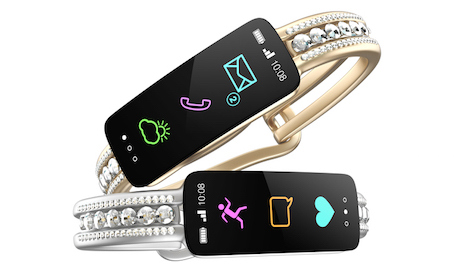- About
- Subscribe Now
- New York,
December 16, 2016

 Beautiful diamond bracelet with smart information display. Luxury wearable gadget idea. Original design. 3D rendering with clipping path.
Beautiful diamond bracelet with smart information display. Luxury wearable gadget idea. Original design. 3D rendering with clipping path.
By Andi Simon
People still love each other. They are just showing it in different ways.
Shifting social conventions have caused many consumers, especially millennials, to no longer find it necessary to marry their significant other. This, is turn, has impacted many high-end businesses, not the least of which is the luxury jewelry industry.
To help navigate a sustainable way to weather these changes – better yet, to capitalize on them – we met with jewelers from across the United States recently to discuss strategy.
Many of them had built their businesses around weddings, with a particular concentration on diamond engagement rings. As these sales have fallen precipitously year over year, they now must change their focus. But to what?
For starters, turn to fresh, innovative ideas for opening new markets and connecting with today’s buyers.
For the future of their industry, jewelers large and small must now adapt to the changes that are already here, as well as the ones that are on the way:
1. Technology
One brand that is firmly in touch with the future is Swarovski.
As it launches its new “smart jewelry” initiatives, it is seeking to reinvigorate its brand with an eye toward Silicon Valley.
“Tech companies can disrupt whole industries within a couple of months,” Markus Langes-Swarovski, 42, chairman of the board of the Swarovski Group and a great-great-grandson of the founder, told The New York Times. “We need to do that to ourselves before it happens to us.”
Similarly, online luxury retailer Net-A-Porter is scheduled to open a technology hub in March 2017, part of a five-year plan to “further disrupt the traditional retail model through digital and mobile integrations.”
2. Demographics
Weddings and marriage are not occurring as they did in the past. This is a major blow to those who focus on wedding rings and diamonds for their core business.
As proof, take a look at these statistics from Pew Research:
• In 2012, 78 percent of men and 67 percent of women had not married by age 25. Less than 50 years ago, it was the reverse: by the age of 25, only 28 percent of men and 13 percent of women had not married
• Today, the median age at first marriage is 29 for men and 27 for women, up from 23 and 20, respectively, 50 years ago
3. Sharing economy
Due to financial concerns and decreased social pressure to marry, young people are living with each other rather than getting married. Or they are living at home or renting a room in an apartment. Couples may get married one day but not quickly.
4. Retail shopping for luxury is changing rapidly
For luxury jewelers, the shift to online shopping seems to have come as a recent shock.
Our jewelers described prior reasons why someone came into their stores: the relationship with the client, the expertise of the jeweler and the experience of buying something of great value in a beautiful setting.
Remember, consumer behavior is shifting.
While today’s jewelers need not completely abandon their stores, bricks-and-mortar increasingly needs to be combined with digital or online options.
An IBM research study proves this point.
The company surveyed more than 26,000 consumers around the globe regarding how they preferred to shop in the future. Past habits still continued, as “90 percent of consumers said they visited a physical store before making their last purchase, 35 percent of these shoppers were unsure whether they would make their next purchase in a store or online, and 9 percent of in-store shoppers used a mobile device during their visit to compare prices and read customer reviews – a digitally savvy demographic that is on the rise.”
Time for new strategy?
Massive changes are not coming – they are here. That calls for agility, innovative thinking, forging more mutually beneficial relationships with manufacturers, and shifting one’s attitude towards the consumer.
Today’s buyers want fast, personalized solutions, delivered through channels that suit their lifestyles. Successful brands recognize this – think Zara with its just-in-time clothing, to name one.
Now is the time for the entire luxury jewelry industry to realize that the way forward is to adapt and change, again and again.
To stand still is to go irrevocably backward.
 Andi Simon is a corporate anthropologist, speaker, commentator and CEO of Simon Associates Management Consultants
Andi Simon is a corporate anthropologist, speaker, commentator and CEO of Simon Associates Management Consultants
Andi Simon is a corporate anthropologist, speaker, commentator and CEO of Simon Associates Management Consultants, Yorktown Heights, NY. Her latest book on leadership is called “On The Brink: A Fresh Lens to Take Your Business to New Heights.” Reach her at asimon@simonassociates.net.
Share your thoughts. Click here